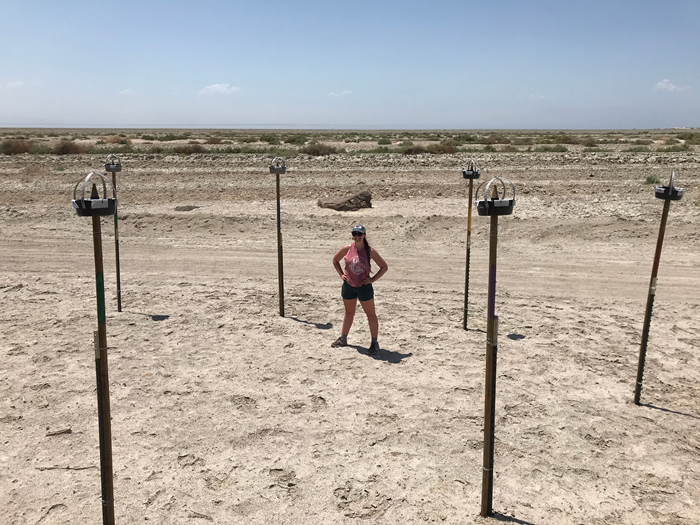Reviewed by Lauren HardakerOct 23 2025
Not only does dust from the drying Salton Sea in California smell awful, but researchers at UC Riverside discovered that inhaling the dust rapidly alters the microscopic environment within the lungs.
 UCR researcher collecting dust from the Salton Sea. Image Credit: Linton Freund/UC Riverside
UCR researcher collecting dust from the Salton Sea. Image Credit: Linton Freund/UC Riverside
Previous studies have revealed that genetic or bacterial diseases affect lung microbes. However, this is the first time scientists have discovered such alterations due to environmental exposure rather than disease.
The study, published in the journal mSphere, found that inhaling airborne dust gathered in a small, landlocked lake affects the microbial environment and immune responses in otherwise healthy mice.
Even Salton Sea dust filtered to remove live bacteria or fungi is altering what microbes survive in the lungs, UCR mycologist and lead study author. It is causing deep changes to our internal environment.
Mia Maltz, Study Lead Author and Mycologist, University of California, Riverside
Scientists have extensively researched the gut microbiome, correlating it to digestion, immunity, and mental health. In contrast, the lung microbiome is not fully understood, despite its growing importance to general health.
Our lab studies discovered that the dust generated at the Salton Sea can have significant health effects especially in the lung, and it is likely a major factor in the high incidence of asthma in the nearby communities.
David Lo, Study Author and Distinguished Professor, Biomedical Sciences, University of California, Riverside
The researchers created an exposure chamber that simulated real-world air conditions. They collected dust samples near and away from the Salton Sea and then subjected mice to the aerosolized particles in a series of one-week experiments.
Even before a more extensive analysis, there were some indications of negative consequences.
Salton Sea residents have ongoing suspicions that the environment is linked to respiratory illness, and our lab has definitely felt the effects of the heat, dustiness, and pungent air while out there on field work.
Talyssa Topacio, Study Co-First Author and Graduate Student. University of California, Riverside
“The dust also just doesn’t smell good, When we were processing it in the lab, it could be stinky,” said Emma Aronson, Study Author and Environmental Microbiologist, University of California, Riverside.
Pseudomonas and Staphylococcus, both associated with respiratory inflammation, were among the bacterial species that colonized mice exposed to sea dust. The most impacted samples had a high concentration of bacteria that generate LPS, a molecular residue on their outer membranes that has been shown to induce immune responses.
“We think microbial products like LPS are part of what’s causing the inflammation. It’s like breathing in a chemical fingerprint of dead bacteria,” added Maltz.
Certain dust samples were very powerful. In one example, up to 60% of lung immune cells showed signs of neutrophil activation, indicating serious inflammation. Neutrophil levels in mice inhaling filtered air were barely 10 to 15 %.
According to Aronson, the findings question long-standing assumptions in pulmonary research.
“We’ve seen these kinds of microbial shifts in people with cystic fibrosis or infections. But these mice had no pre-existing conditions. This was a clean slate, and it still happened,” said Emma Aronson.
As the Salton Sea's lakebed dries out, more hazardous material is released into the atmosphere. The study team is investigating whether local children experience comparable microbial alterations.
“Breathing in the dust over time may have chronic impacts in the lung, and these studies on the potential for altering the lung microbiome are an important first step in identifying factors that could lead to asthma and other chronic diseases,” added Lo.
The study also raises numerous questions. If dust can impact lung microbes, how about smoke, exhaust, or vaping aerosols? The researchers intend to investigate whether additional exposures result in comparable abnormalities.
This study used a technique Maltz developed over four years to separate microbial DNA from host tissue, allowing for a more thorough look at the lung microbiome than ever before. The next stage is to assess whether protective species are disappearing and how long any obvious changes in the microbiome last.
“We’ve only just begun to understand how dust exposure changes the lung microbiome. We don’t yet know how long the changes last, or whether they’re reversible. That’s another big question,” concluded Maltz.
Source:
Journal reference:
Maltz, R, M., et al. (2025) Lung microbiomes’ variable responses to dust exposure in mouse models of asthma. mSphere. doi.org/10.1128/msphere.00209-25.